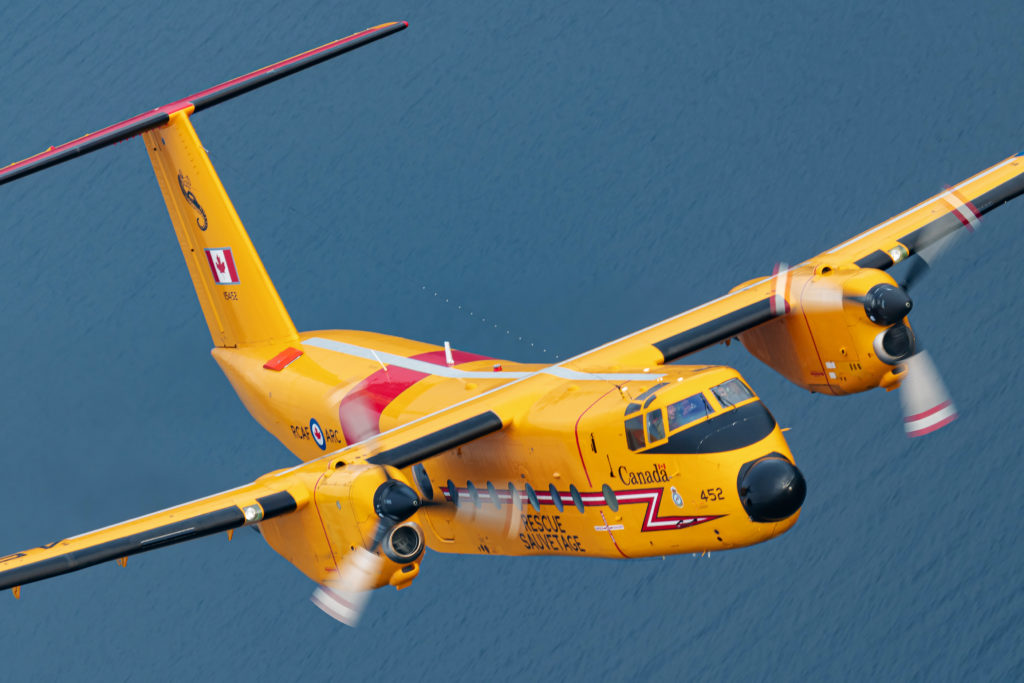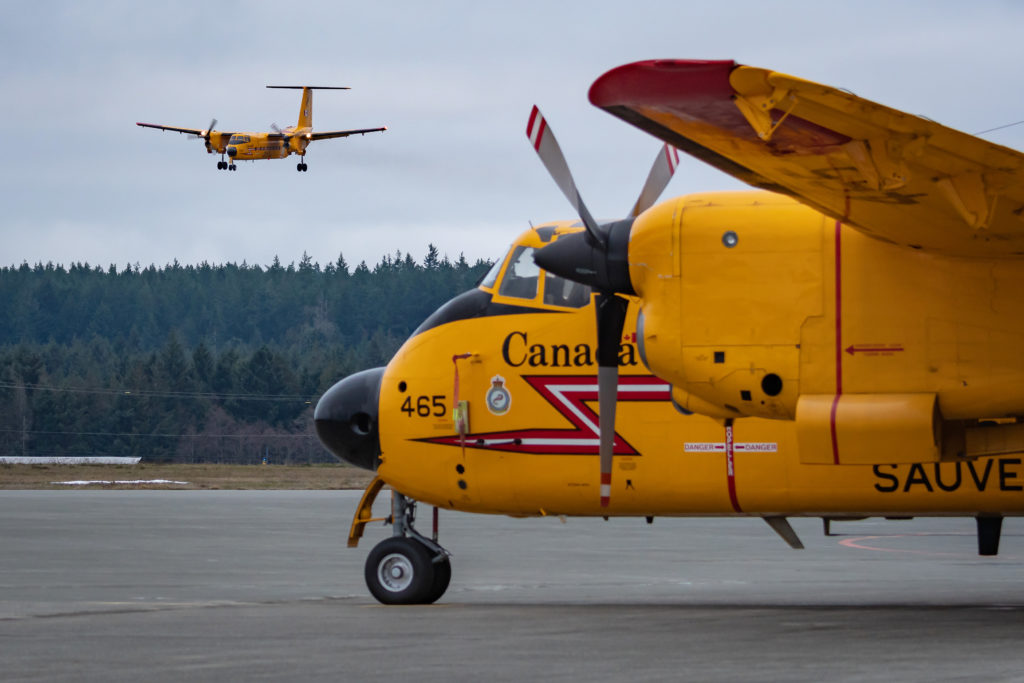Estimated reading time 17 minutes, 10 seconds.
It was probably fitting that weather played a role in the final operational flight of the CC-115 Buffalo. After all, the venerable fixed-wing search-and-rescue (SAR) aircraft has operated in perilous conditions for the better part of 55 years. However, low clouds and instrument flight rules (IFR) visibility were not going to prevent the Buff’s swan song.
On Jan. 15, 2022, No. 115452 took off from 19 Wing Comox, British Columbia, on its last operational SAR standby day — a training mission intended to highlight the crew and aircraft’s capabilities in mountain valleys and over open water, working with ground and maritime partners to locate and rescue Canadians in distress.
There will still be transits to final resting places, at national aviation museums, and Royal Canadian Air Force (RCAF) training schools. But the flight that day marked the last mission for the de Havilland Canada-built DHC-5 utility transport turboprop that first entered service in 1967 with 429 Squadron in Saint-Hubert, Quebec. Able to take off and land from rugged airstrips no longer than a football field, the CC-115 assumed the SAR role in the ‘70s and has operated from various bases across the country since. The last six of the original 15 aircraft have been operated by 442 Transport and Rescue Squadron in Comox since the early 2000s.
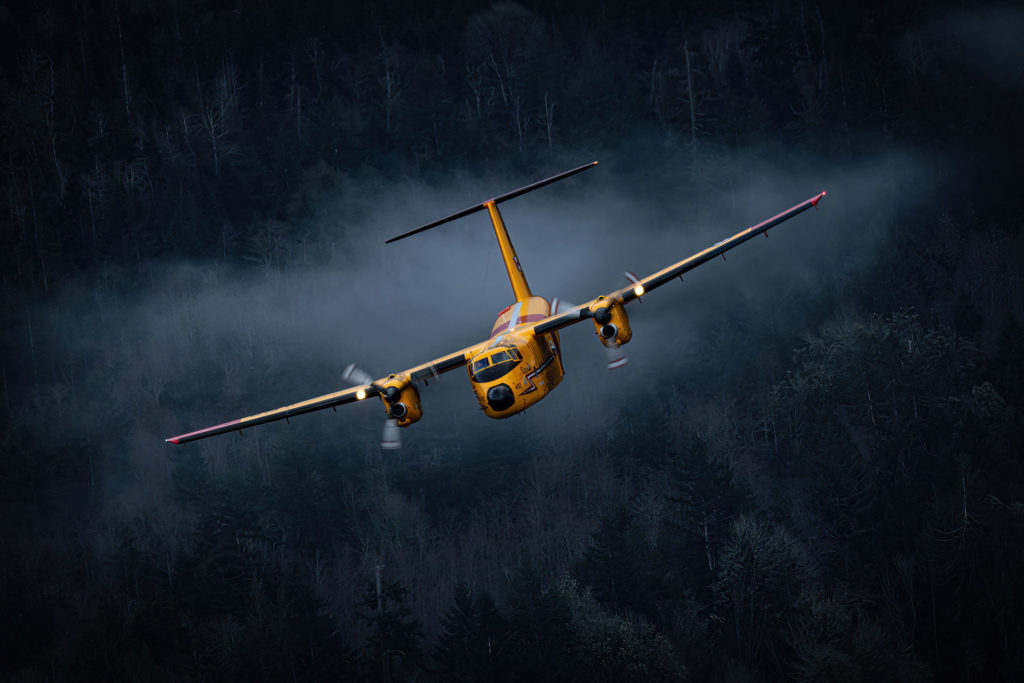
For Captains Fahim Awan and Matthew Hart, the day was one neither will forget. Both are relatively recent converts to the Buff, and only began flying as a team in late 2020. That either was sitting in the cockpit that final day — Awan in the left seat, Hart in the right as the aircraft commander — is a tale in itself. It came down to luck and schedule rotation.
“I think everybody wanted to be flying it on that day,” Awan admitted. “We did get a few other pilots involved, so others got some stick time. But it ended up being luck of the draw.”
Both Awan and Hart began their flying careers as fighter pilots and crossed paths multiple times before winding up at 442 Squadron. Awan, from the Port Coquitlam area of the B.C. Lower Mainland, joined the Canadian Armed Forces (CAF) in 2002. He received his wings in 2006 on the CT-155 Hawk in Moose Jaw, Saskatchewan, before going through fighter lead-in training (FLIT) and then onto the CF-188 Hornet operational training unit (OTU) in Cold Lake, Alberta. He later returned to 2 Canadian Forces Flying Training School in Moose Jaw as an instructor. Then, after converting to the CH-124 Sea King maritime helicopter, a neck injury forced him to consider multi-engine aircraft. In late 2019, he arrived at 442 Squadron and began flying the Buffalo in early 2020.

Hart, from Parksville on Vancouver Island, signed up for the Canadian Army’s infantry Reserve in 2003 before joining the Regular Force in 2006 as a pilot. He, too, obtained his wings on the CT-155 Hawk, in 2009, and went through FLIT and the Hornet OTU before returning to Moose Jaw as a Hawk instructor. Hart had grown up watching the Buffalo and CH-113 Labrador flying the coastline of Vancouver Island, and knew at some point he wanted to return home to fly SAR. In the summer of 2018, he was posted west to 442 Squadron and began flying the Buffalo operationally in 2019.
Though they were an experienced crew of pilots, flight engineers, navigators, and SAR technicians, the occasion on Jan. 15 created a heightened level of excitement, Awan admitted. “That each of the maneuvers [we planned] was the last time we were going to do it added some impact.”
The event also had the attention of much of the Air Force, past and present, and aviation photographers keen to capture the moment — most of whom would be in a second CC-115 Buffalo. Awan and Hart had approval to fly a standard training day mission, but they wanted to showcase a range of the Buffalo’s strengths, including working with the CH-149 Cormorant flown by the Squadron’s commanding officer, LCol Jean Leroux.

“It was a neat way to bring almost everybody in the flight together,” said Awan. But it required “a lot of coordination to deconflict” airspace with the two other aircraft, and fix rendezvous times with partners such as the Canadian Coast Guard and Royal Canadian Marine Search and Rescue.
LAST FLIGHT
As with most flight plans, the weather that morning had a deciding vote for the last training flight of Buffalo 115452, the workhorse of the squadron during the past year. “It was actually IFR weather,” said Hart.
As he and Awan coordinated with CC-115465 (the second Buff that would serve as a photo platform), the Cormorant launched to conduct a weather check, breaking through the cloud cover at about 3,000 feet. “That was great news for us,” said Hart. “We knew we could go up, do a cloud break up . . . and operate visually in the mountains.”
For the first capability demonstration, both Buffalos took off after the Cormorant and headed inland to the mountain range outside Strathcona Park for contour flying down a valley — a coordination challenge with three aircraft in “a smaller piece of sky.”
They considered a parachute drop of the SAR techs, a dynamic way to show the interaction between the fixed-wing platform and the Cormorant, which would extract them, in a simulated backcountry scenario.
“We went through those conversations airborne, but the weather was not conducive to letting the SAR techs jump to the mountains given the mechanical turbulence and the winds that day, even though it was very clear,” said Hart.
From the mountains of Vancouver Island, the three aircraft then broke down beneath the clouds and met up with a Royal Canadian Marine SAR zodiac in the Strait of Georgia, simulating a vessel in distress taking on water. Descending to about 500 feet, the Buffalo crew dropped a simulated message – SAR speak for a two-way radio – and then a heavy-duty bailing pump. SAR techs require a minimum of 2,000 feet for a training jump from the ramp of a Buffalo, but the cloud ceiling never rose much above 1,500 — the necessary clearance for visual flight rules (VFR) operations.
The final demonstration of the morning involved up-wind, down-wind, and cross-wind drops of equipment bundles — weighted jerry cans meant to simulate the same characteristics and drift as medical equipment, food, tents, and camping gear — over Goose Spit, a point near the Comox Valley Marina that the squadron uses for training. “We had three pretty good [final] drops,” said Hart.
In the afternoon, the three aircraft and crews crossed the strait to work with the Powell River Coast Guard, dropping Sea Rescue Kits (SRKs) — life rafts often tethered together by 600 feet of rope. The Buffalo typically carries four SRKs and the SAR techs will drop them in bundles of two, three, or all four.
“That’s usually our last resort,” said Awan. “If the [bailing] pump can’t keep up or they are abandoning ship, we drop the SRK. We try to encircle the target we are dropping to so that both life rafts open around the people in the water. We usually drop [simulated SRKs] in training. But this time, because it was the last, we dropped a live SRK.”
That drop was particularly poignant for both pilots. Though it is something crews constantly train for, few actually execute operational drops. “It is a bit of a rite of passage for a SAR crew to be able to do that,” said Hart.
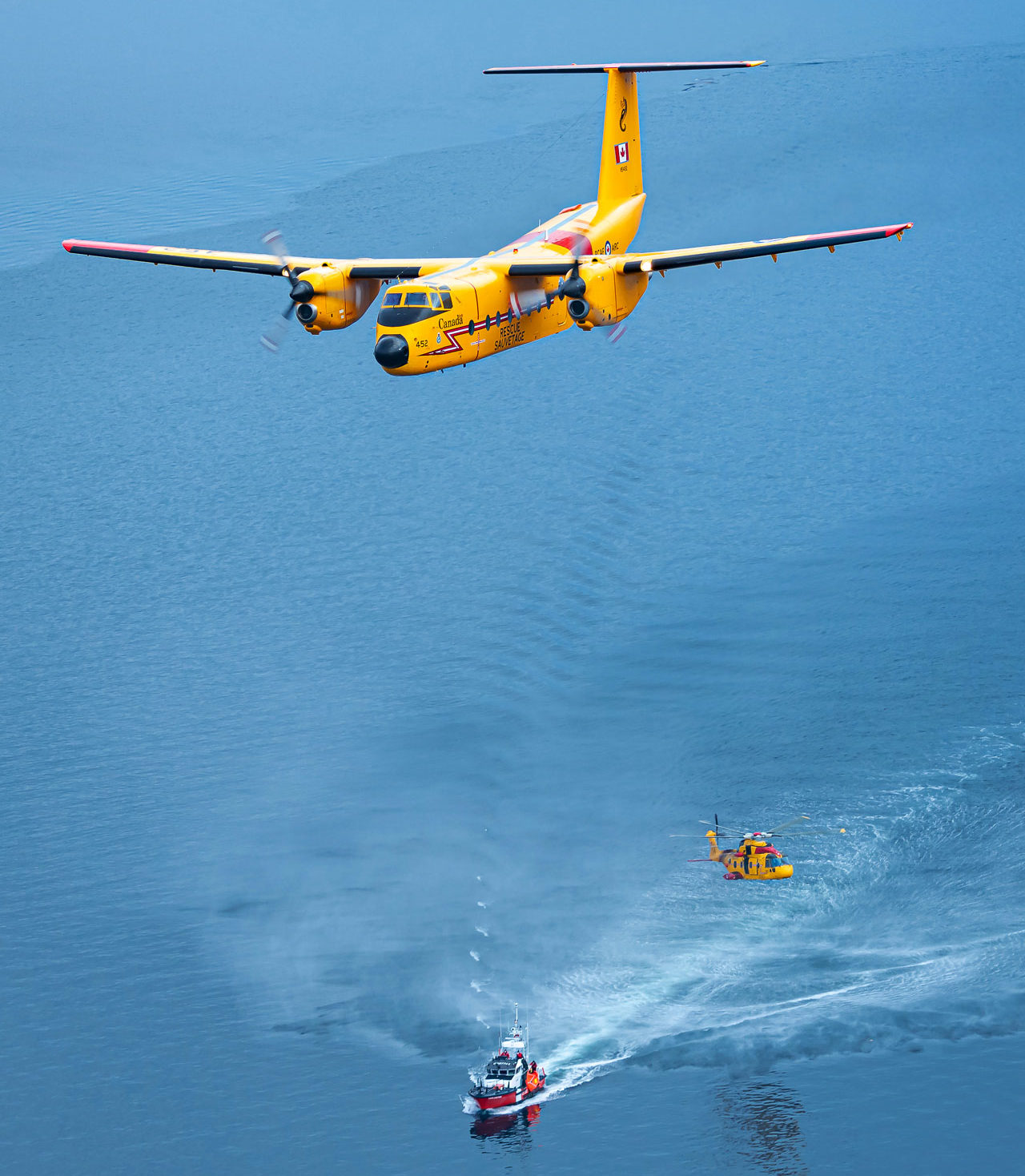
OPERATIONAL EXCELLENCE
In November 2021, the Buff’s final flight aircrew was tasked to assist an American-registered sailing boat that had caught fire north of Vancouver Island. The Buffalo was airborne conducting a training exercise over Goose Spit with military passengers, when the SAR phone rang and turned them north, through bumpy 40-knot winds and extremely poor VFR visibility.
They reached the search area within an hour and located the 45-foot vessel engulfed in flames and billowing black smoke, with little left above the hull. A civilian aircraft in the vicinity helped “talk on” the crew to a dinghy battling a sea state of three-meter (10-foot) waves and high winds.
“Without that pilot to get our eyes on, it would have been hard [to find it],” said Awan. “It was a speck in the water of white caps.”
The two men in the dinghy were desperately attempting to row the boat away from a “craggy shoreline” that likely would have “mangled” the boat. They were also taking on water because they didn’t have time to plug the transom before they launched.
The Buffalo crew dropped illumination flares to mark the dinghy, and then “dropped them a message on 600-foot rope to establish two-way comms,” said Hart. “We could hear the desperation in their voices.”

The Cormorant was still an hour out, and a fishing vessel approaching the area was unable to get close to the shore without putting itself in danger.
“To bridge the gap [between the fishing vessel and the dinghy], our SAR techs did a remarkable drop with the SRK and an extra 600 feet of rope,” said Awan. “I was flying the plane and got us down and dirty, low over the water, but those guys did a miraculous drop. It literally connected the fishing boat to the dinghy with the rope,” which was then able to pull the dinghy away from the rocks.
“It was honestly the first mission where I thought the Buffalo single-handedly made a huge impact,” added Awan. “I don’t know what would have happened if we hadn’t been there. Matt and I found out later it was the first time an SRK drop had been done in a decade.
“For me, that was probably the highlight of my career as a SAR pilot so far,” he continued. “That was on our minds when we were dropping the SRKs on the [final flight].”
The final operational flight on Jan. 15 ended with a flyover of the town of Comox — a last salute to the many who have supported the aircraft. Awan then lined up the CC-115 for its final approach on Runway 36, hammered on the reverse when the wheels touched, and pulled on to Taxiway D and went through the “bird bath” that greets all aircraft that operate low over salt water.
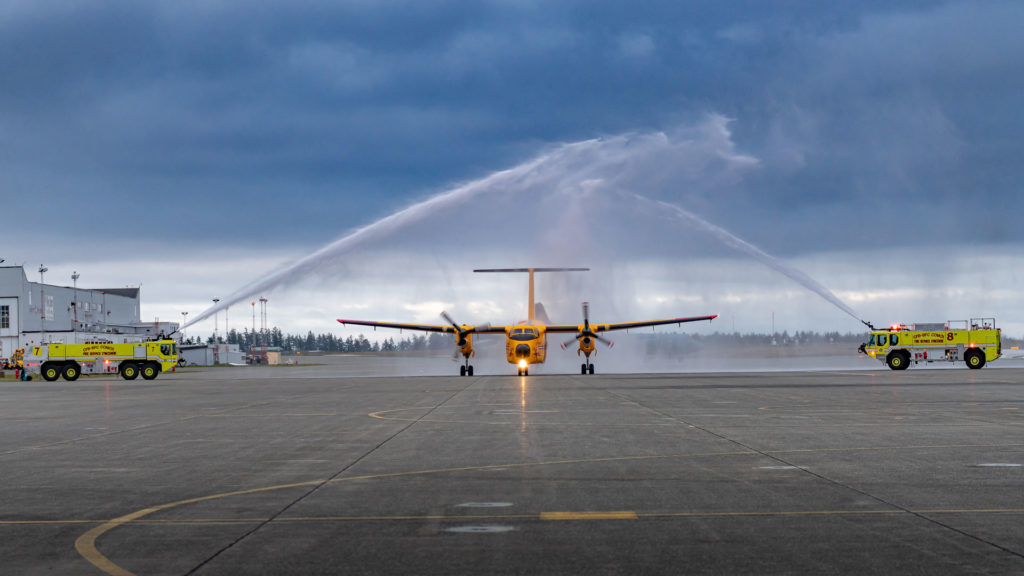
Finally, they taxied through a “shower” from fire truck hoses before stopping on a flight line of aircrews, maintenance technicians, and other squadron members who have helped keep the Buffalo in service for over five decades.
“You only get to do that once in your career,” said Awan. “To be at the controls on that day, in that moment, is something I’m never going to forget. It was pretty special.”
Hart’s thoughts were on the many CAF personnel and civilians “directly impacted by the Buffalo’s service. I was thinking about the responsibility we had to fly it that last day,” he said. “It’s had so many roles, not just SAR. I’ll remember this for the rest of my life. It was a very sentimental day, for sure.”
IN WITH THE NEW
The Buffalo is being replaced by the Airbus-built CC-295 Kingfisher, though entry into service has been delayed as it continues to undergo certification and qualification. The new aircraft will introduce modern avionics, sensors, and mission systems, but it will have a lot to do to measure up to the Buff.
Awan and Hart anticipate the new capabilities of the CC-295 will change how SAR operations are conducted. “We may not have to fly between the rocks looking for somebody with our eyeballs anymore, the sensor suite will do a lot of that for us,” noted Hart. “I think the tactics will change, but the 295 is going to have huge shoes to fill because the Buffalo has been an amazing SAR aircraft for so long.”

Derek Heyes Photo 
No. 115452 being pulled out of the hangar at 19 Wing. Derek Heyes Photo 
The final operational flight of the CC-115 Buffalo involved air-to-air shoot with the only other Buffalo still flying, No. 115465. Derek Heyes Photo
Determining how best to operate the Kingfisher is part of the ongoing test and evaluation process. The RCAF had expected to declare initial operational capability by summer 2022. The Department of National Defence said in an email that the timeline “is shifting to allow for aircraft certification and qualification, which has been running longer than originally anticipated as a result of the volume and complexity of the work associated with developing the CC-295 capability, and the global Covid-19 pandemic.
“A revised schedule is currently being subjected to an extensive analysis that itself will take some time to complete because of its complexity. We are still analyzing and assessing the situation, working closely with Airbus, and expect to have more concrete information about the full impact in the next month or so.”
In 2016, the Canadian government acquired 16 CC-295s to replace the last six Buffalo and 12 CC-130 H-model Hercules that perform a SAR role with squadrons at 8 Wing Trenton, Ontario; 14 Wing Greenwood, Nova Scotia; and 17 Wing Winnipeg, Manitoba. To date, four CC-295s have arrived in Canada and five have been completed in Seville, Spain. Until the Kingfishers assume the SAR role, CC-130H aircraft and crews from 17 Wing will support 442 Squadron and its five Cormorant helicopters.
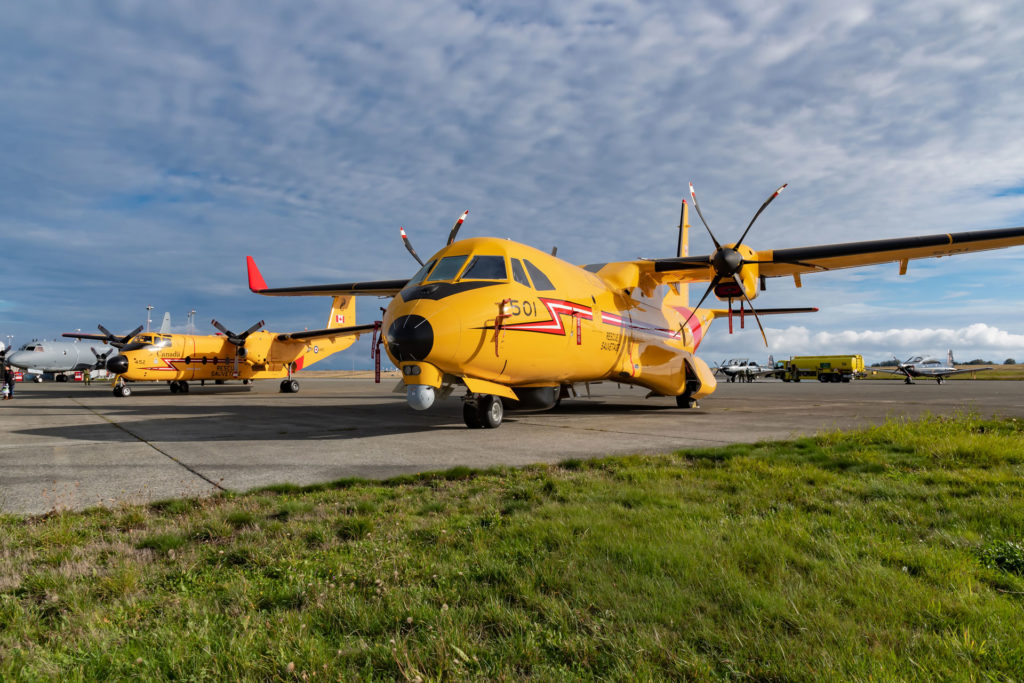
For Awan and Hart, their aircraft may no longer be operational, but both intend to continue in SAR. “This is my community now, fixed-wing search-and-rescue,” said Hart, who also serves as the pilot leader for 442 Squadron. “Staying in 19 Wing is the primary goal for me. I will be the conduit between all our pilots that will be outsourced or utilized within different units at 19 Wing.”
“It’s been a roundabout route for both of us to get here,” said Awan, who chairs the retirement committee for the Buffalo. “But it’s been everything we expected and more. We get to put all of our training to use in this job. And it’s so cool when you get to make a difference, save someone and get back with their family. That is infectious.”

